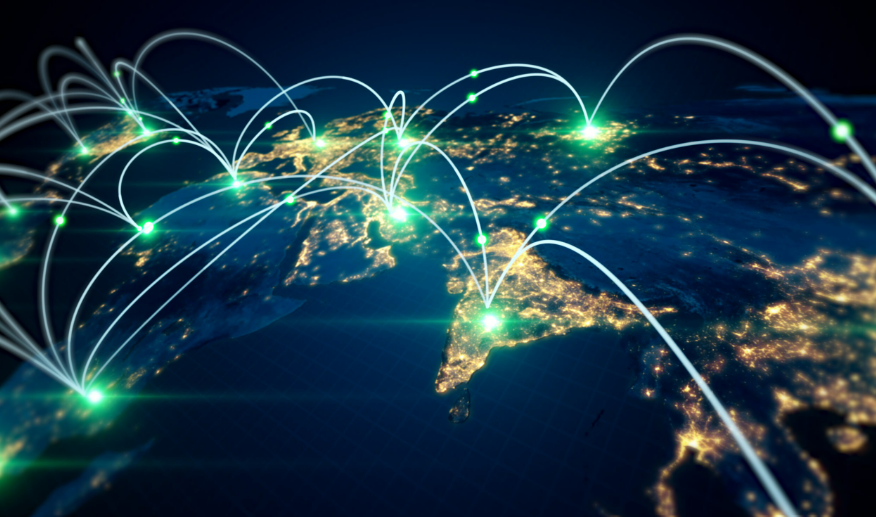In today’s world, countries are no longer isolated — they are connected through trade, investment, communication, and technology. This growing interconnection is called globalisation.
Globalisation has turned the world into a global village, where goods, services, ideas, and people move freely across borders. Companies produce and sell their products in many countries, creating links between national economies.
This chapter helps us understand how globalisation works, the role of multinational corporations (MNCs), and how it has impacted the Indian economy — bringing both new opportunities and new challenges.
Introduction
Meaning of Globalisation
- Globalisation refers to the process by which countries are connected through trade, investment, technology, and movement of people.
- It creates a global economy where goods, services, and ideas flow freely across borders.
World as a Single Market
- Due to globalisation, the world is becoming increasingly interconnected — like a single large market.
- Companies can produce in one country, sell in another, and get services from yet another.
- Example: a T-shirt might be designed in the USA, made in India, and sold in Europe — showing interdependence among nations.
Role of MNCs (Multinational Corporations)
- MNCs play a major role in the process of globalisation.
- They set up offices or factories in different countries to produce and sell their products globally.
- Aim of MNCs: To earn more profit by producing goods at lower costs and selling them across the world.
Impact on Indian Economy
- Globalisation has opened new opportunities for Indian companies and workers.
- It has also increased competition between Indian and foreign companies.
Main Idea of the Chapter
- The chapter explains how globalisation is shaping our lives, influencing production, trade, and employment in India.
Topic-1: Production Across Countries
Meaning
- Production of goods and services is no longer limited to one country.
- Different stages of production often take place in different countries to reduce costs and use resources efficiently.
Why production happens across countries?
- Cost advantage: Producing in countries where labour or raw materials are cheaper.
- Skills and technology: Some countries have better technology or skilled labour for certain tasks.
- Market Access: Producing close to the major markets save transport costs and time.
Global Value Chain:
- Goods are produced in stages across different countries.
- Each country contributes according to its advantage like cheap labour, raw materials, technology, etc.
Impact on countries:
- Positive: Employment opportunities, access to advanced technology, growth in exports.
- Negative: Dependence on foreign countries, local industries may face competition.
Topic-2: Interlinking Production Across Countries
Meaning:
- Production of goods is often split across countries, with each country contributing a part of the process.
- This creates a network of interconnected production known as global production networks.
How it works?
- Different countries specialise in tasks they can do efficiently (based on costs, skill or technology).
- Example: Components made in one country – assembled in another – sold globally.
Advantages:
- Reduces production costs.
- Spread up production using global expertise.
- Enables countries to benefit from trade and advanced technology.
Disadvantages/Challenges:
- Dependency on multiple countries; disruption in one can affect production globally.
- Local industries may face competition from foreign products.
Topic-3: Ford Motors (Case Study)
Company Background:
- Ford Motors is a multinational automobile company based in the USA.
- It produces cars, trucks, and other vehicles for markets around the world.
Global Production Strategy:
- Ford Motor uses different countries for different stages of production:
- Designs may be made in the USA.
- Car parts may be manufactured in countries like India, Mexico, or China.
- Final assembly can happen in another country close to the target market.
Reasons for Such Strategy:
- Reduce Costs: Cheaper labor and materials in some countries.
- Access to Local Markets: Manufacturing in a country helps reach local customers efficiently.
- Specialised Skills: Different countries provide expertise in design, technology, or production.
Impact on India:
- Creation of jobs in manufacturing and services.
- Transfer of technology and skills.
- Encouragement for local suppliers and small businesses to grow.
Topic-4: Foreign Trade and Integration of Markets
Meaning of Foreign Trade:
- Foreign trade refers to the exchange of goods and services between countries.
- It includes imports (buying from other countries) and exports (selling to other countries).
Purpose of Foreign Trade:
- To expand markets for producers.
- To allow consumers access to goods not produced domestically.
- To connect producers and consumers globally.
Before Foreign Trade:
- Markets of different countries were separate and disconnected.
- Each country mostly traded within its own borders.
After Foreign Trade:
- Goods travel from one country to another — for example, Indian spices sold in the USA or Chinese toys sold in India.
- Producers can sell products in foreign markets, and consumers can buy foreign goods.
- This leads to the integration of markets across countries.
Meaning of Market Integration:
- It means the markets of different countries become connected or interlinked.
- Prices and demand of goods in one country can now affect those in another.
Topic-5: Chinese Toys in India
Background:
- Earlier, most toys sold in India were made by Indian toy manufacturers.
- But after globalisation and foreign trade increased, Chinese toys entered the Indian market.
Why Chinese Toys Became Popular:
- Cheaper Prices: Chinese toys were available at lower prices compared to Indian ones.
- Attractive Designs: They were colorful, battery-operated, and looked more appealing to children.
- Large Variety: Chinese manufacturers produced toys in huge quantities and different types.
Impact on Indian Toy Industry:
- Indian toy producers faced tough competition.
- Many small Indian toy units had to shut down due to loss in demand.
- Employment in the Indian toy industry decreased.
Effect on Consumers:
- Indian consumers benefited from low prices and more options.
- However, there were also concerns about safety and quality in some imported toys.
Topic-6: What is Globalization?
Meaning:
- Globalisation is the process by which the world’s countries are becoming interconnected through trade, investment, technology, and the movement of people and information.
Main Features of Globalisation:
- Free flow of goods and services between countries.
- Free movement of investment and capital.
- Transfer of technology and skills across nations.
- Increased role of multinational corporations (MNCs).
Role of MNCs:
- MNCs play a major role in connecting different countries through their production and trade activities.
- They set up offices and factories in various parts of the world to sell products globally.
Effects of Globalisation:
- Increases trade and employment opportunities.
- Brings new technologies and products.
- Increases competition between local and foreign companies.
Topic-7: Factors of Globalization
Meaning:
- Factors of globalisation are the main reasons or forces that have helped in increasing connections among countries across the world.
Major Factors Responsible for Globalisation:
(a) Rapid Improvement in Technology:
- Technology has reduced the cost of production, communication, and transportation.
- Transport advancements (like faster ships, airplanes, and containers) make it easy to move goods quickly and cheaply.
- Information and communication technology (ICT) helps in instant contact between producers, traders, and consumers worldwide (through mobile phones, internet, video calls, etc.).
(b) Liberalisation of Foreign Trade and Investment Policy:
- Many countries, including India, have removed trade barriers like taxes and restrictions.
- This allows free movement of goods, services, and investments between nations.
(c) Role of Multinational Corporations (MNCs):
- MNCs have set up factories and offices in many countries.
- They spread production, technology, and jobs worldwide, linking national economies together.
(d) Role of WTO (World Trade Organization):
- The WTO promotes free trade among countries by encouraging them to follow common trade rules.
- It helps increase global cooperation in business and commerce.
Topic-8: World Trade Organization (WTO)
Introduction:
- The World Trade Organization (WTO) was established in 1995.
- More than 160 countries are members of the WTO.
- It is an international organisation that aims to promote free and fair trade among countries.
Main Functions of WTO:
- Sets rules for international trade to ensure smooth business between countries.
- Encourages free trade by reducing trade barriers like import duties and quotas.
- Settles trade disputes between member countries.
- Monitors trade policies of different nations to ensure fair practices.
WTO and Developing Countries:
- WTO supports globalisation, but developing countries often face unequal competition from developed nations.
- Developed countries sometimes demand open markets in poor nations but protect their own products with subsidies.
- This makes it hard for small producers in developing countries to compete.
Importance of WTO:
- Helps countries to trade with each other more easily.
- Encourages investment and economic cooperation worldwide.
- Promotes global economic growth and integration.
Topic-9: WTO – Debate on Trade Practices
Unequal Benefits of Globalisation:
- Although the World Trade Organization (WTO) promotes free trade, the benefits are not equally shared among all countries.
- Developed countries often gain more advantages than developing countries like India.
Developed Countries’ Practices:
- Developed nations encourage poor countries to remove trade barriers, so they can sell their goods easily.
- But they protect their own farmers and industries through subsidies (financial support).
- This makes their products cheaper in the global market, creating unfair competition for producers in developing countries.
Impact on Developing Countries:
- Farmers and small producers in poor countries find it hard to compete with low-priced goods from rich nations.
- Many local industries suffer losses or close down due to this competition.
Supporters’ View:
- Supporters of WTO argue that free trade increases global growth, creates new markets, and gives consumers more choices.
- It also helps developing countries attract investment and improve technology.
Opponents’ View:
- Critics say WTO rules often favour rich countries, making it difficult for poor nations to protect their local industries and farmers.
Topic-10: Impact of Globalization in India
Introduction:
- Globalisation has brought many changes in India’s economy since the 1990s.
- It has affected production, trade, employment, and lifestyle in both positive and negative ways.
Positive Impacts:
- Increase in Foreign Investment (FDI):
- Many Multinational Companies (MNCs) have set up factories, offices, and businesses in India.
- This has brought new technology, capital, and job opportunities.
- Expansion of Indian Companies:
- Several Indian companies (like Tata, Infosys, Wipro, and Reliance) have become multinational companies themselves and are competing globally.
- Improved Quality and Variety of Products:
- Due to competition, consumers get better quality goods at reasonable prices and have more choices.
- Growth in Services Sector:
- Globalisation has boosted sectors like IT, communication, banking, and tourism, which employ millions of people.
- Increase in Exports:
- India now exports more goods and services such as software, textiles, and engineering goods.
Negative Impacts:
- Unequal Benefits:
- Large companies and skilled workers have benefited more than small producers and unskilled workers.
- Rural and small industries often face tough competition from foreign products.
- Job Insecurity:
- Global competition has led to casual and temporary employment, with fewer job guarantees.
- Effect on Small Producers:
- Many small-scale industries have shut down because they cannot compete with big MNCs and cheap imports.
- Cultural Impact:
- Western lifestyles and consumer habits are spreading, leading to loss of traditional Indian culture in some areas.
Topic-11: Struggle for a fair globalization
Meaning:
- Fair globalisation means ensuring that the benefits of globalisation are shared equally among all countries and all people — especially workers, farmers, and small producers in developing nations.
Problems with Present Globalisation:
- The current form of globalisation mainly benefits rich countries and large companies.
- Small producers, workers, and developing nations often face losses due to unequal competition and unfair trade rules.
What is Needed for Fair Globalisation:
- Globalisation must be managed and guided by policies that protect the interests of the poor and vulnerable groups.
Steps to Achieve Fair Globalisation:
- Government Role:
- Make laws that protect workers’ rights and wages.
- Support small-scale industries and farmers with loans, infrastructure, and training.
- Ensure foreign companies follow labour and environmental laws.
- People’s Organisations:
- Trade unions, NGOs, and social groups can raise awareness and pressurise governments to adopt fair policies.
- International Cooperation:
- Developing countries can unite and demand fair rules in organisations like the WTO.
Topic-12: Special Economic Zones (SEZs)
Meaning:
- Special Economic Zones (SEZs) are specific areas set up by the government to attract foreign and domestic investment.
- Companies in these zones get special facilities and relaxations to promote industrial growth and exports.
Purpose:
- To encourage multinational companies (MNCs) and Indian firms to set up industries in India.
- To increase exports, create more jobs, and boost economic development.
Facilities Provided in SEZs:
- Better infrastructure like roads, electricity, and water supply.
- Tax benefits and lower duties for companies.
- Simplified laws and faster approvals for starting businesses.
- Freedom to import and export goods more easily.
Examples of SEZs in India:
- SEZs are located in places like Noida (U.P.), Kandla (Gujarat), Cochin (Kerala), and Vishakhapatnam (Andhra Pradesh).
Benefits:
- Attracts foreign investment.
- Creates employment opportunities.
- Promotes industrial growth and exports.
Concerns:
- Sometimes farmers lose their land for SEZ development.
- Small industries outside SEZs may not get similar advantages.
Conclusion
Globalisation has made the world more connected and interdependent than ever before. It has brought new opportunities for countries like India — in terms of trade, investment, employment, and access to modern technology. Indian companies have grown stronger, and consumers enjoy a greater variety of goods at better prices.
However, the benefits of globalisation are not shared equally. Large companies and skilled workers have gained more, while small producers, farmers, and unskilled workers often struggle to compete.
Therefore, for globalisation to be truly fair and beneficial for all, the government and international organisations must ensure equal opportunities, fair trade rules, and protection for the weaker sections of society. Only then can globalisation lead to inclusive and sustainable development for everyone.
Full Chapter Explanation
Detailed notes of other chapters:
Class-10th Economics Chapter-1 Development (NCERT Notes)
Sectors of Indian Economy: Class 10th Economics Chapter-2 ( Easy NCERT Notes )
Money And Credit: Class 10th Economics Chapter-3 ( Easy NCERT Notes )
Consumer Rights: Class-10th Economics Chapter-5 ( Easy NCERT Notes )






